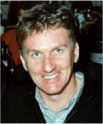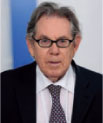Articles citing this paper
Perspectives on our planet in the Anthropocene
Jonathan Williams A B and Paul J. Crutzen A
+ Author Affiliations
- Author Affiliations
A Max Planck Institute for Chemistry, D-55128 Mainz, Germany.
B Corresponding author. Email: jonathan.williams@mpic.de

Prof. Jonathan Williams is an atmospheric chemist. He completed his B.Sc. and Ph.D. at the University of East Anglia, England, and after working as a postdoctoral researcher at the NOAA Aeronomy laboratory in Boulder, USA, he became a research group leader at the Max Planck Institute for Chemistry, Germany, with a focus on the investigation of the chemistry of volatile organic compounds (VOCs) in the atmosphere. He has participated in many international field campaigns on aircraft, ships and at ground stations. He is editor on several journals and recently co-authored the textbook The Atmospheric Chemist's Companion.
|

Born in 1933 in Amsterdam, Prof. Paul J. Crutzen was trained as a civil engineer and worked with the Bridge Construction Bureau of the City of Amsterdam. In 1959 he joined Stockholm University (MISU) to study meteorology and atmospheric chemistry. His research has been especially concerned with the natural and anthropogenically disturbed photochemistry of ozone in the stratosphere and troposphere. Thereby he identified the importance of nitrogen oxides emitted by fossil fuel and biomass burning, especially in the tropics, as important sources of air pollution with potential impacts on ozone and Earth climate. He served as Director of Research at the National Center of Atmospheric Research in Boulder, Colorado, 1977–80, and thereafter, until his retirement in 2000, at the Max Planck Institute for Chemistry in Mainz. Until April 2008 he did part-time research at the University of California, San Diego, Scripps Institution of Oceanography. In 1995 he received the Nobel Prize for Chemistry for his work on atmospheric ozone.
|
Environmental Chemistry 10(4) 269-280 https://doi.org/10.1071/EN13061
Submitted: 19 March 2013 Accepted: 27 May 2013 Published: 20 August 2013
Environmental chemistry in the twenty-first century
Ali Hazrat, Khan Ezzat
Environmental Chemistry Letters. 2017 15(2). p.329
Introductory lecture: atmospheric chemistry in the Anthropocene
Finlayson-Pitts Barbara J.
Faraday Discussions. 2017 200 p.11
Grand Challenge for Frontiers in Environmental Chemistry—Inorganic Pollutants
Mason Robert Peter
Frontiers in Environmental Chemistry. 2020 1
A New Assessment Framework for Transience in Hydrogeological Systems
Currell Matthew,
Gleeson Tom, Dahlhaus Peter
Groundwater. 2016 54(1). p.4
Multiphase Chemistry at the Atmosphere–Biosphere Interface Influencing Climate and Public Health in the Anthropocene
Pöschl Ulrich, Shiraiwa Manabu
Chemical Reviews. 2015 115(10). p.4440
A decade with Environmental Chemistry
Francesconi Kevin
Environmental Chemistry. 2020 17(5). p.353
The Anthropocene: a primer for geographers
Castree Noel
Geography. 2015 100(2). p.66
Opposite OH reactivity and ozone cycles in the Amazon rainforest and megacity Beijing: Subversion of biospheric oxidant control by anthropogenic emissions
Williams Jonathan,
Keßel Stephan U.,
Nölscher Anke C.,
Yang Yudong,
Lee Yue,
Yáñez-Serrano Ana Maria,
Wolff Stefan,
Kesselmeier Jürgen,
Klüpfel Thomas,
Lelieveld Jos, Shao Min
Atmospheric Environment. 2016 125 p.112
Microplastics in coastal and marine environments of the western tropical and sub-tropical Atlantic Ocean
Costa Monica F., Barletta Mário
Environmental Science: Processes & Impacts. 2015 17(11). p.1868
Ernest Gellner’s Legacy and Social Theory Today (2022)
Conversi Daniele
Distribution, sources and consequences of nutrients, persistent organic pollutants, metals and microplastics in South American estuaries
Barletta Mário,
Lima André R.A., Costa Monica F.
Science of The Total Environment. 2019 651 p.1199
Mega-scale groundwater quality challenges and the need for an inter-disciplinary approach
Currell Matthew
Hydrogeology Journal. 2014 22(4). p.745
Addressing the Anthropocene
Anbar A. D.,
Romaniello S. J.,
Allenby B. R., Broecker W. S.
Environmental Chemistry. 2016 13(5). p.777
Systematic Review of Fish Ecology and Anthropogenic Impacts in South American Estuaries: Setting Priorities for Ecosystem Conservation
Barletta Mário, Lima André R. A.
Frontiers in Marine Science. 2019 6
Over the hills and further away from coast: global geospatial patterns of human and environment over the 20th–21st centuries
Kummu Matti,
de Moel Hans,
Salvucci Gianluigi,
Viviroli Daniel,
Ward Philip J, Varis Olli
Environmental Research Letters. 2016 11(3). p.034010
Special challenges in the conservation of fishes and aquatic environments of South America
Costa M. F., Barletta M.
Journal of Fish Biology. 2016 89(1). p.4
What on earth? The impact of digestates and composts from farm effluent management on fluxes of foodborne pathogens in agricultural lands
Piveteau Pascal,
Druilhe Céline, Aissani Lynda
Science of The Total Environment. 2022 840 p.156693
Telling Time: Chemistry Education in the Anthropocene Epoch
Mahaffy Peter G.
Journal of Chemical Education. 2014 91(4). p.463
Characterization and Analysis of Microplastics (2017)
Costa Monica F., Duarte Armando C.
Urban transformation stories for the 21st century: Insights from strategic conversations
Moglia Magnus,
Cork Steven J.,
Boschetti Fabio,
Cook Stephen,
Bohensky Erin,
Muster Tim, Page Declan
Global Environmental Change. 2018 50 p.222
Geochemistry of Chilean Rivers Within the Central Zone: Distinguishing the Impact of Mining, Lithology and Physical Weathering
Viers J.,
Carretier S.,
Auda Y.,
Pokrovsky O. S.,
Seyler P.,
Chabaux F.,
Regard V.,
Tolorza V., Herail G.
Aquatic Geochemistry. 2019 25(1-2). p.27
Past and present conservation of South American estuaries
Barletta Mário,
Melo Roger C.B., Whitfield Alan K.
Estuarine, Coastal and Shelf Science. 2023 295 p.108542
The first Sherry Rowland Tribute Paper: Williams and Crutzen mark the beginning of the Anthropocene
Francesconi Kevin A.
Environmental Chemistry. 2013 10(4). p.i
Air Pollution and Climate Change Effects on Allergies in the Anthropocene: Abundance, Interaction, and Modification of Allergens and Adjuvants
Reinmuth-Selzle Kathrin,
Kampf Christopher J.,
Lucas Kurt,
Lang-Yona Naama,
Fröhlich-Nowoisky Janine,
Shiraiwa Manabu,
Lakey Pascale S. J.,
Lai Senchao,
Liu Fobang,
Kunert Anna T.,
Ziegler Kira,
Shen Fangxia,
Sgarbanti Rossella,
Weber Bettina,
Bellinghausen Iris,
Saloga Joachim,
Weller Michael G.,
Duschl Albert,
Schuppan Detlef, Pöschl Ulrich
Environmental Science & Technology. 2017 51(8). p.4119
Coastal Wetlands: Alteration and Remediation (2017)
Barletta Mário,
Lima André R. A.,
Costa Monica F., Dantas David V.




